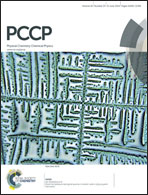Selective adsorption of bismuth telluride nanoplatelets through electrostatic attraction†
Abstract
We demonstrate a facile technique to assemble solution phase-synthesized bismuth telluride (Bi2Te3) nanoplatelets into arrays of micropatterns. Aminosilane self-assembled monolayers (SAMs) are printed on silicon dioxide (SiO2) substrates using microcontact printing (μCP). The SAM printed surfaces are terminated with amine-groups allowing Bi2Te3 nanoplatelet selective adsorption by electrostatic attraction. Using Kelvin probe force microscopy, the electrical potential difference between aminosilane SAM and Bi2Te3 nanoplatelet surfaces is found to be ∼650 mV, which is larger than that (∼400 mV) between the SiO2 substrate and Bi2Te3 nanoplatelet surfaces. The selective adsorption provides an opportunity for integrating solution phase-grown topological insulators toward several device-level applications.


 Please wait while we load your content...
Please wait while we load your content...